by Michael Shea.
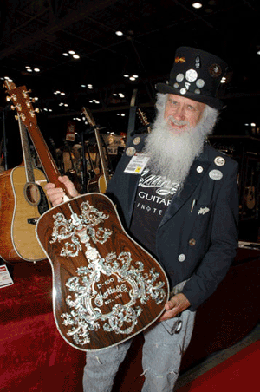 |
|
Charles (Chuck) “The Duke of Pearl” Erikson. Photo by Eileen Llorente. |
Charles (Chuck) “The Duke of Pearl” Erikson was born in Los Angeles in 1942. He’s been an integral personality and industry mover and shaker in the world of luthiery and inlay for over 40 years, becoming celebrated among instrument builders, furniture makers and jewelers for the nacreous shell inlay material he supplies. His company processes nearly 300 tons of shell each year from 18 different species and holds three U.S. patents on shell material.
Chuck’s background is not limited to meeting inlay supply and demand or building his own stringed instruments. Chuck’s life has been an exploration of eclectic experiences and endeavors that defy any idea of a run of the mill existence. His livelihoods and interests have included snake hunting, gold mining, dealing in scrap metal, manufacturing mining claim signs, and serious antiquing. And these only skim the surface of his fertile mind and seemingly endless series of splendid pursuits.
Chuck has an intimate knowledge of the world of inlay and in addition to selling shell out of his sales center in Hanover, Pennsylvania, he provides technical support to builders, and devotes long hours of his time developing new processes, products, and markets for inlay materials. Clad in a top hat and tux coat Chuck attends industry tradeshows as the easily recognizable Duke of Pearl. He’s also the co-inventor with Larry Sifel (Founder, Pearl Works, Ltd.) of Abalam, a product that is best described as a thin shell, laminated into sheets.
I spent some time in December 2006 with Chuck at his home in rural Grass Valley, California. First impressions are always insightful, but I really wasn’t expecting to be sharing my time with Chuck and his pet rattlesnake. He and his lovely wife, Cheryl, live in a log cabin they built that sits near the end of a quiet and fairly isolated dirt road. It seems to be the perfect place for a spiritual existence where ideas can be hatched and a life of strong organic values can be nurtured and thrive.
The world of inlay seems to be a pretty specialized artistic endeavor. Let’s hear about some of the outstanding inlay artists of all time and those that are still around that you hold in the highest regard.
Chuck Erikson: Well, that’s a pretty rarified list. I mean a list of the real top guys would start with Grit Laskin, up in Toronto. In fact, there’s a book on his work [“A Guitar Maker’s Canvas”] that came out in 2003. It’s worth taking a look through that to see what sort of stuff he’s doing. But he’s really at the top of the craft. He’s a real storyteller, not just an ornamental artist; he actually does some really complex themes in the story telling in his art. There’s all kinds of hidden meanings and stuff, so it’s not just simple surface ornament.
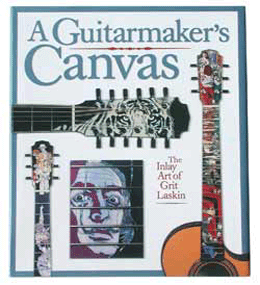 |
|
Grit Laskin’s A Guitarmaker’s Canvas |
So he would be right up at the top. And then Larry Robinson, who has done a lot of work for a lot of companies but most famously and recently, he did the Million Dollar Martin, which is their one-millionth guitar, and spent a couple of years working on it. This involved collaboration with a master engraver, David Giulietti, who really just went over the top on the details on the ornament. And it was just to celebrate Martin’s being in business 177 years, and they wanted to blow it all out on this incredible guitar which they actually take around to shows and let folks handle and play the thing.
So Larry, he also has a book out, called “The Art of Inlay”, that shows a lot of his work, as well as stuff from other top artists. And he’s really up there. And then a newcomer to the top, but who’s been developing his inlay approach for quite a few years, as he’s a guitar builder, but in the last five or six years he’s really pulled it all together artistically and stylistically – that’s Harvey Leach, who lives about 20 minutes from here out on Highway 174, and he’d be a great guy for you to go talk to. But he’s currently working on some amazing stuff, and he’s done projects for Godin and Martin. He’s done some real high-end one-off guitars for Martin, that are in the hundred thousand dollar and up range. He’s really incredibly good, to the point where he’s developed a relationship with Larry Robinson, and Larry refers work to him because he’s a guy that will do it at his level. He doesn’t have a problem saying, Harvey can handle it. And he’s going to make it the same quality of work that you’d get if you went to Larry himself. Pretty hard to find a guy you can refer to like that, so he’s not just a local phenomenon, he’s a world-class inlay guy, right up there with the top half dozen or so.
And then David Nichols in Malone, New York, who’s been doing inlay, has been building instruments, guitars, banjos, and especially mandolins, for years and years. In fact, I knew him back in the sixties! For many, many years up to the present, he has been Martin’s custom shop. If they get one-off requests for an inlay, it goes to Dave. And he works in a more traditional style. He’s really known for doing vine type inlays. You know, leafy stuff. But he’s just a master at it. He’s not a free form guy like Grit or Larry are. He works more in traditional, ornamental themes. But he’s also at the top.
And then there’s some guys, who’ve been doing CNC [Computer Numerical Control] work in the last decade or so, and although it’s not hand work, it still takes immense artistic and programming skills. If you’re not an artist and start using CNC, it’s going to just look like crummy CNC-cut inlay.
 |
|
Chuck “The Duke of Pearl” Erikson. Photo by Michael Shea. |
But it has to all be actually designed to be cut-able with the CNC machine. That’s where Pearl Works in Maryland comes in, founded by Larry Sifel, who died just this last May [2006], and who was my business partner actually, with Duke of Pearl for the last 4 ½ years. He really was the guy that got things going with CNC work, and he absolutely has the top shop in the world for design sense and the amount of detail; spider web detail, working down to .010” diameter bits and stuff. So they’re the top.
And then the next CNC shop under him would be Tom Ellis’ Precision Pearl in Austin, who also can do really incredibly delicate stuff with a great sense of design. Tom’s also a mandolin builder who after being out of building for a while, just came back in the last year, and he’s introducing a line of really fine high-end F5 style mandolins. In fact I talked to him today and he mentioned Gibson’s going after everybody that’s building Gibson style instruments.
They recently had a five million dollar lawsuit against Stan Werbin at Elderly Instruments, and they’ve sent letters out to a lot of the small custom shops. Historically, Gibson’s influenced everybody, and a lot of my own building involved making Gibson style instruments because people back in the sixties didn’t want something that wasn’t Gibson or Martin. But now, under Henry’s rule at Gibson they’re trying to go around and just shut down anybody that’s using the bell shape truss cover, or Gibson peg head, or Gibson inlays, Gibson body shape, anything. And that’s going to really impact the industry.
You know it’s going to tick off a lot of people and it’s going to really make a problem for all the replica instruments that are floating around out there. Stan Werbin had simply put up for sale a Gibson copy banjo, that was being sold as a Gibson copy, but Gibson forced him to buy it back and turn the instrument over to them. Well, that’s going to create problems. And a lot of the inlay work that’s been done traditionally, up until just the last decade or so, has been copies of Martins and Gibson’s, you know. Martin is not at all touchy about it. They actually encourage people to copy their old instruments, Chris Martin does. He helps sponsor luthier’s conventions and says, “Hey, you guys, copy them all you want. We want you to, and if something of yours starts selling out there, it tells us when to plan model re-issues.” A symbiotic relationship, rather than adversarial. So, Chris is cool. But some other big C.E.O.’s obviously aren’t.
How did you get started with inlay, who introduced you to it?
CE: Well, initially I was living in Denver, Colorado and just got involved as a little know-nothing kid. I was about 19 or 20 or something. And I started helping out at a small, new local little music store called The House of Banjos. And you know, I just hung out in there.
I didn’t play banjo but wanted to learn, and I’d always been fascinated with the sound of a bluegrass banjo, even when I didn’t know what I was listening to as a really little kid. And then later found out what it was when I was in Denver, and decided that I’d just get a cheapo open-back instrument and take a lesson. And the place I did it through, since I hung out there, you know, the owners would go out for sandwiches and say “Hey, watch the place while we’re gone.” Well, eventually, I became a partner in that shop after about a year or so. The House of Banjos eventually went out of business, but it was during that time I’d actually started taking instruments apart and doing set-up work for them. And I thought, “You know, I think I could make one of these.”
So I just made a neck, and I had an aluminum pot that I designed, that I had cast in the foundry back there. I went up to Boulder and paid a visit to Chuck Ogsbury, at Ode Banjos, who gave me a few tips and some encouragement. I was going to try to make a cheap instrument because there was a folk boom going on during the sixties. And when I came back to California and opened my shop up [February 1965] and I had an Erika Banjo sign out there, I’d never even built a whole instrument. The only complete instrument I had, I had built by another guy, Will Durant, down in the Pomona area. I just told him what to do, and he really did the machining and the building on it while I only did some decorative carving on the neck. But I took it around and told people I built it.
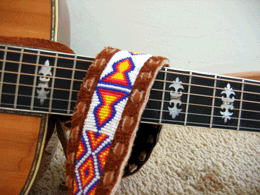 |
|
1969 Bob Givens and David Cross Dreadnaught. Photo by Rick Landers. |
You know, I took it back stage at the Ash Grove in L.A., and finally got an order. And then I had to sit down and go “what am I going to do now?” Because I’d never built an instrument, you know. And of course, with banjos inlay is a very integral part of the job. And so, I was just scrambling. I was calling guys that were already building.
There were a few shops around like Bob Givens and Dick Allen in El Monte, and Bill Robeson at Tradition Banjo, and Art Gariepy in Long Beach and a small number of other guys. But really nobody would tell me how to do anything. In fact some of them gave me deliberately wrong information just so I would screw things up when I got back to the shop.
But master guitar builder Roy Noble, who was about five minutes from my own shop in Van Nuys, really took me in, as did Bob Givens, who was really friendly, he’s dead now, he was a mandolin and guitar builder and made a lot of banjo necks. And he showed me, you know, how to do some inlay stuff. But I wound up, like, holding the saw upside down. I mean, I didn’t know the difference and I had the handle on top instead of underneath, which is how I cut to this day!
I got some pearl flat blanks from a supplier and just practiced. What I did on my very first banjos is, I would always do a practice set of inlays on the back of the fingerboard before it was glued on. And then glue it on and inlay the real set. If you ever x-rayed some of them old instruments you’d see another set of inlays going on that’s inside the neck. Just for practice. So, my first attempts were passable. I wouldn’t be ashamed to see them now but they’d be rough by later standards. But it was just a stupid way to go into business, since I didn’t know what I was doing.
I was bold and brash and, if I’d had any kind of prudence I would have waited until I’d known more, and probably never done it. So, anyway, yeah, I kind of sneaked in through the back door. And then just as I was doing that the whole folk music boom collapsed. And the big market for banjos, especially high-end banjos, just went away. I wound up, at one point, where it was hard to get a source of good pearl. The stuff I was getting through a place in New York, and through Franz Dotzauer [Erlangen, W. Germany], was just real cruddy stuff. It wasn’t flat. Had a lot of flaws in it.
So you could already tell the difference between good and bad mother of pearl?
CE: Oh yeah. Bad pearl you just break blades. You break shell. It’s got hidden cracks. It’s got worm holes that get in the way. It’s got, you know, you’d get a pound of shell and maybe three or four ounces was really usable. Well, some of the stuff that I got even had Gibson script logos already cut out of them and I was just getting the scraps, you know. But, Bob Givens, again, at one point, finally told me where he was getting shell. Because he always seemed to get good stuff. And it was from a guy over on the coast, John Guzowski in Wilmington.
So I called John and said I’d like to come down and get some shell. “Well,” he said, “You better do it fast because I’ve just decided, the last couple of weeks, to sell the business. It’s up for sale.” So I went down there and got talking to him and said, “What do you want for it?” And he said, “Well, I’d like $500 for the grinders and all the shell here, and I’ll teach you how to do it.” I didn’t have 500 bucks, but it was like a Friday or Saturday night you know, so I wrote a check. And then scrambled like crazy to cover it before it got to my bank. Went back Saturday with a trailer, hauled everything to my shop. And I thought, well, you know, possession really counts here. It’s like somehow or another I’ll make that check good.
Anyway, by Tuesday I’d just called in the money from anybody that owed me anything, and got it in the bank and so, at that point I was basically set up to process my own shell. And then went through a real learning period. I mean, for the first year as I was grinding, I had all these orders. People just loved the stuff I was putting out.
So you were just selling the shell to others at this point?
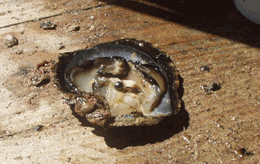 |
|
The raw material – Pacific oyster. |
CE: Well, yeah, but basically I intended to grind it mainly for myself. And, of course, Bob wanted some and Tut Taylor in Nashville wanted shell. He was also used to getting it from Guzowski, so I inherited a few customers and they said, “Well, hey, how about grinding some shell for me?” And so, well, yeah, its a few extra dollars. I’m an instrument builder, but I also don’t mind making a couple of bucks. But I found out after a year, although I’d been selling those blanks at the price that John Guzowski, the prior owner had told me, when I added it up I was actually selling it for less than I had in it.
When I called John I said, “How did you make a profit at this?” And he said, “Oh, didn’t I tell you?” I said, “What?” And he says, “Well, I took all the scraps from cutting the shell and we cut and tumbled those, and I had my wife and daughter making jewelry out of that, and that actually generated all the money to pay for the materials and a lot of the time. So, the blanks were pure profit.” I said, “Well, no, you didn’t tell me that.” So, I had to do some adjustments. It got to the point where at first I was just supplying guys I pretty much knew, and then I started getting calls from people from out of state, folks that I had never heard of.
So the word was getting around.
CE: The word was getting around and, eventually, it got to the point, by the early seventies where I was grinding so much shell and actually had several guys working for me, that I just couldn’t build any more. The last banjo I made, the guy waited 11 years for! And that was because he got his order in just as it was getting really impossible to find time to build, and he kind of talked me into building one more instrument. It was Elmo Shropshire, who’s in a group called The Homestead Act. I think he’s still around, probably. But they had a bluegrass group that played a lot of the lounges in Vegas and Reno. And I’d done some work for him before, built him a couple of necks. But this last instrument, in fact it was funny that he, when he first put the order in, of course was all excited. You know, we’d talk a couple of times a week, and then just every couple of weeks.
And so I started it, got off to a bang you know, got things glued together and got going on it. But it just wasn’t possible to build. And after awhile he was just calling me maybe every couple of months. Then it actually got to where he was calling me once a year, after about six or seven years. And I finally said, “Elmo if you’re going to call and bug me every year I’m not going to work on it at all.” And when I finally finished it, I actually had to have another builder, Larry Cohea in Berkeley, finally put the lacquer on the instrument because I just couldn’t do it. But at last I got it to Elmo.
He sent me a really nice note and said, “Boy, it was worth the wait. You’re the greatest!” He’s about the coolest customer you could have. But at that point I’d been in business as a banjo builder since 1965, just after I got back from Denver. That’s all in that bio I gave you. And then moved up here to Grass Valley in late ’79, and by that time I was pretty much not building any more. I was still selling woods and hardware and slotting fingerboards for Fender, Santa Cruz Guitars, and a lot of small builders, but I was mainly doing shell and selling ivory, tortoise shell, and that kind of stuff. But the pearl thing just became the main business.
It seemed like you got into building because you loved it, so when you transferred into the shell business did you love that too or was it just a way to make money?
CE: Well, I didn’t like it as much as building. In fact for quite awhile I sort of resented the fact that I had to spend so much time processing shell and it was taking me away from my luthiery. As a businessman I was pretty stupid, because I made a lot better money processing shell than I would ever make building instruments. That’s where my heart was, with instruments. But eventually, it wasn’t like I hated grinding shell, although it was real rough work. It was dusty, and I still have the scars on my knuckles from going into the edge of the grinders. But it was good work. I was in touch with a lot of builders, so I was only about once removed from building. I got to talk a lot about instruments.
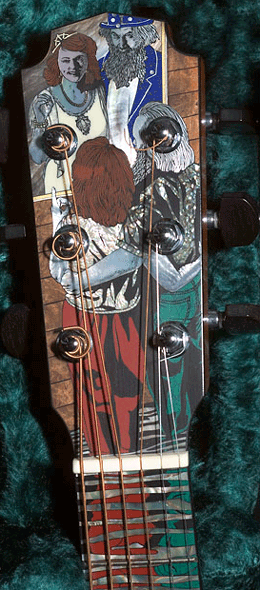 |
|
Grit Laskin’s “Ten Hands”. Photo by Michael Shea. |
I was still giving advice. I was involved in other people’s building processes. So it wasn’t like totally alien. And it was good money. I mean, for the first time in my life I was able to actually get my rent paid on time and buy four new tires at once and stuff. So, it eventually just became the main thing. And I don’t really have any regrets about it. I mean God blessed me with this great business!
I’m dealing with the coolest people in the world. For instance, I don’t get bad checks. There’s not a better bunch of guys than acoustic builders. It’s a little different with electric guitar guys. They’re a real seedy, bottom-of-the-barrel lot.
We won’t print that!
CE: You can if you want, I don’t care. Traditionally, there’s always been a lot more trouble dealing with electric guys than acoustic guys. It’s as though the acoustic guys are almost like fly fishermen, the gentlemen of the industry, and the electric guys are really the rabble-rousers, kind of a pretty low ethic, you know. Talk to music stores and they’ve got the same problem. Any time you’re dealing with drums and electric guitars you’ve got a lot more problems with people stiffing you and bills not getting paid.
Maybe it’s that rocker image of the electric guitar?
CE: It’s a whole rebellious, self-centered kind of thing. And acoustic guys tend to be really psychologically different. I mean, I don’t really care if you print it or not, it really has nothing to do directly with inlay, but …
Interesting perspective. It’s like an acoustic guitar, I don’t know I think you’re more in tune with the wood.
CE: Yeah, some of the skills are more highly technical. I mean, like classical and flamenco techniques and with some of the stuff, there’s really good electric players that’re doing mind-boggling things. But, generally, they don’t spend months and months and months figuring out one piece like a classical player would, you know. Some of the steel string and finger picking guys have just amazing flat pick and finger picking techniques. I mean really beyond what most electric guys would ever get into. And I think that takes a little more discipline in your life. And that relates to inlay because most of my inlay is with acoustic guys more than it is with electric. And maybe that’s why I just never have any problem getting paid. Which really makes it enjoyable.
Where did your “The Duke of Pearl” moniker come from?
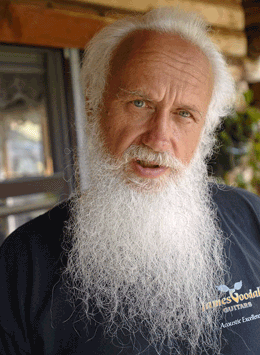 |
|
Chuck “The Duke of Pearl” Erikson. Photo by Michael Shea. |
CE: Originally I was Erika Banjos, and then when I got out of building and was just doing pearl work, at one point I simply shut the whole pearl production thing down and went into storage. And I just didn’t do anything in the industry for several years. I did gold mining. But when I had a chance to get back, well, when Cheryl and I bought this property, we got the house built and that took like 2-1/2 years, and I was looking for something to do for a living. And I didn’t want to get a job in town, because it’s been a lot of years since I’ve had to, or been forced to work in tall buildings, you know. I’ll work really hard to keep from getting a job!
And I told Cheryl, well, I’m going to see if we can get some sort of home business up and running. I became a scrap metal collector and dealer and I’d run the stuff down to [Sacramento] and sell it, and made anywhere from $500 to $1,000 a month doing that. And then I came out with a line of mining signs that I’d silk-screened myself and sold those to all the hardwares up and down the Sierras. So up here in the gold country, you see those white signs on the trees by the river, you know, that say “NO PANNING,” and those are all my signs. Yeah, I made most of those, you know. Because up to that point there really wasn’t a source for those. So that brought in a little income.
And I was just doing odds and ends and I told Cheryl I was going to try to get a business going and so I thought, we’ve still got all these abalone shells from the old business, a big pile of gunnysacks that were stored outside. The bags had all decayed. They’re all overgrown with berry bushes. We went over and sorted them out. We re-bagged them and put the business, my whole stored business up for sale for 500 bucks and I couldn’t find a taker.
Ran ads. Upped the price. Finally at one point I really put it together and got all the paperwork gathered up and put a value on it of $34,500. Well, at that point, Gibson got interested in buying it for their new Montana Division, through new V.P. Steve Carlson. And I sold it to them in February of 1989. Went back there for a month and set up an Erika Division, the name being derived from “Erika Banjos.” They bought the Erika name. But then they decided not to sell to the general industry, and to only use the shell in-house. Well, it didn’t work out for them, and so several years later they just dismantled the operation and gave me permission to get back into it if I wanted to. So I made contacts overseas to have processing done in South Korea, and also in Indonesia now. So I got back into it.
I called instrument builder Larry Sifel, who had Pearlworks and who had taken my place supplying blanks to the industry. And he said he didn’t really enjoy doing that. He wanted to see if he could make a business doing CNC inlay cutting. We were old friends and he said, “Yeah, it wouldn’t hurt me. Go for it.” So I began making blanks and started going to some luthier shows, but by now I was kind of out of touch with things. And a local sign maker, Jim Moser, who was just starting to make a convention table sign for me, well I told him I was thinking of calling the business Duke of Pearl because I couldn’t use the Erika name, and because people used to come into my shop years ago and sing Duke, Duke, Duke, Duke of Pearl, Duke, Duke. And it was always kind of a joke.
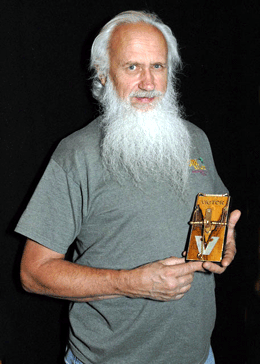 |
|
Chuck “The Duke of Pearl” Erikson with inlaid rat trap. Photo by Michael Shea. |
So I thought, well I’ll just use that as a new business name. And then the guy that was making the sign, which is right here, by the way, this is the sign he made, [Chuck pulled out the sign] I still take it to the shows, he said, “Well, you ought to get a top hat and…” well there’s the top hat! So I wear a top hat and a tux coat with pearl all over it. I went to a GAL [Guild of American Luthiers] convention back in South Dakota, I think it was the first time I ever did it and I thought, I’m just a fool. These luthiers, they’ll show up all dressed in work clothes and I’m showing up like this idiot, you know. Well, it turned out it went over really big. Everybody liked it and I was getting videotaped and got a lot of attention.
And so it just kind of became the trademark, with the top hat and the tux coat. Of course, it wasn’t long before Cheryl started dressing up as The Duchess, too. So it was kind of based on suggestions, I mean the Duke of Pearl name came from people singing it when they came into the shop, and then the costume idea came from the guy that made the sign for me. I mean it was actually his idea. So, what do you do without friends? I’m giving you the long answers here.
You talked about pearl and other shell, what additional kinds of materials are currently being used for inlay?
CE: Well, one of the big ones is what’s called “reconstituted stone,” or “recon stone.” And it’s available really through only one source, and that’s Masecraft Supply Co., in Meriden, Connecticut. And it’s real stone that’s been crushed powder fine, and then it’s thickly embedded in a resin, so it’s really dense. And they actually have techniques where they can get the swirl or the glitter. I mean the malachite has little gold flecks in it, and the jade has the black graining. They’ve got about 80 different types of it. Grit Laskin and most of the top inlay artists use a lot of that.
Masecraft has everything from wood grain stuff to lapidary type stuff to different kinds of shell, not pearlescent shell, but things like spiny oyster shell. And you can’t slab it quite as thin as pearl, but you can slab it thin enough so it’s workable. You can cut it with a handsaw, and file or sand it, and it really looks like rock. So the recon stone is a big one. But they also use a countertop material called Corian, which is made in a whole range of colors and textures. And then different metals, like copper, brass, aluminum, silver, whatever, both sheet and wire. Larry Robinson’s philosophy is, if he can cut it with a saw he’ll use it for an inlay. And so he actually goes to yard sales and looks for plastic children’s toys that have different colors and brings them home and cuts them up, and he gets a whole range of plastic colors, you know.
Would any inlay material affect the tone of an instrument? There’s no issue with that?
CE: No. Not really, even if you did the whole fingerboard in pearl. It’s so thin it doesn’t really add significant weight. I mean maybe a couple of ounces in the neck. But that’s not acoustically detectable. If you did the fingerboard in pearl, the surface would be harder than the ebony. If it was a fretless instrument, you’d be able to hear the difference, but on a fretted instrument, the note’s coming off the top of your fret wire and not off the fingerboard material. So, you just can’t hear a difference.
If you’re bending a note, would it feel different? Would it screech?
CE: No, there’s no scratch or anything like that would show up. That really has to do with the kind of finish you put on the board. I mean if you did a rough finish on ebony, you’d probably get a little scratchy hang up to a note, but usually on fingerboards, they don’t buff them out generally. They’ll go down to maybe a 600 sanding grit, so it’s kind of a satin feel. Usually you wouldn’t just hit it with a buffer and shine it up to a high gloss. That can actually be kind of grabby. But yeah, acoustically, I’ve never heard of anybody actually detecting a change. There are guys that would argue that. But I would consider that to be in the field of what’s jokingly called “psycho acoustics.” Because if it was done behind a curtain they couldn’t hear it, I don’t think you can tell the difference, but if you’d tell them what’s going on they’ll hear a difference.
I read on the Internet that you are credited with the invention of Abalam. How did that come about?
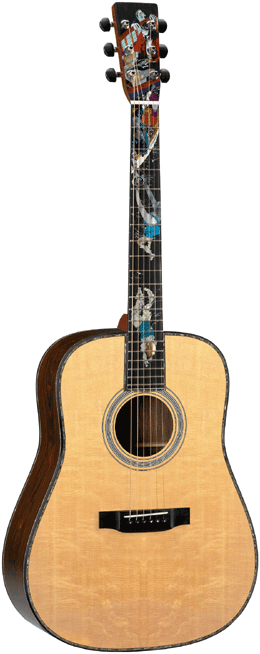 |
|
Grit Laskin’s “Night Drive” Martin Guitar. Photo courtesy of Martin Guitar. |
CE: I started getting shell processed over in Seoul, South Korea. We were initially having a lot of problems with the blanks, with the quality. They just didn’t seem to be able to get it right. And so at one point Cheryl and I just took what was literally our last few dollars and went over there. I took a suitcase full of shells and some marker pens and we got together with the factory manager who speaks English, and we went to the little shops that were doing our work. And I just sat down and showed these guys how they had to do it. And if they couldn’t get it, it meant we were going to be out of business. But that turned it around.
They actually started producing stuff that was really useable, that was the quality we needed. While I was over there, in one of the shops, I noticed these big kind of canvas wheeled bins like you see at the post office, and they were full of bundles of shell with little colored ribbons tied around them. And I picked one up and it was these paper-thin pieces of shell, about maybe five inches long by an inch wide. But you know, only .010” thick. And I’d seen stuff like that used on instruments, especially ones that had been imported.
Instead of doing inlay they would just cut a logo out of that stuff and then just glue it on top of the peghead without inlaying it, and then build up the lacquer over and around it, and it looks like an inlay. But I’d never really seen where that came from. It was a real problem for guys that did refinishing on instruments because if you thought it was an inlay, and you strip the finish off, there’s no inlay, it just comes off with the lacquer. It’s like, vanished! And actually Gibson had started to use a little bit of that stuff.
Is there a name for that technique of just laying it on top?
CE: Yes, it’s an overlay. Inlay is actually put down in a recess, and overlay just goes right up on the surface, its not inlaid at all. So I saw this stuff over there and I was fascinated with it, and so I bought a few bundles and brought them back, as it was pretty cheap and I thought there’s gotta be a way to use it. So I showed it to Larry Sifel at Pearlworks and he got excited about it and actually started using it on some things they were doing for Fender at the time.
He’d actually inlay that stuff because he was using a CNC. It was only .010” thick, but he could put it in an .008” cavity, and so he got away with doing some stuff. Fender started wrapping tuner buttons and tremolo arm handles and it was going into their real high-end custom shop stuff at the time. This was probably back 8 to 10 years ago, something like that. And so he found some limited applications for it, but it was just so hard to work with that small hand-builders kind of didn’t know what to do with it. It’s real fragile, real crumbly.
I was actually at a NAMM show in Anaheim about that time and had a 3-ring binder with page-sized samples of thin stuff I had laminated with plastic so we could handle it. I was having it made from all kinds of shells in big sheets. The stuff I originally looked at over in Seoul was just like, small and narrow single pieces. What I had were 5 ½” x 9 ½” sheets that were each made from many smaller pieces of shell, and sheets made from many different kinds of shells. So I took this book of samples to the NAMM show and I was going around to different booths and talking to manufacturers, and the guy who owned the big shell supply house at the time, Gunther Klier [Shellex, in Gross-Gerau, W. Germany], who I knew and had a good relationship with, he walked up on me while I had this book open talking to a guitar company and I couldn’t just slam it shut on him, so he comes up and says, “Ach, ach, dat’s der tin stuff.” And I go “Yeah, Gunther, it’s really thin all right.” And he says, “Ach, nobody can use dat here.” And I said “Well that’s what I’m trying to figure out, because I think there might be someone who could.” But he says “No, no, no, dat vill nefer verk for anyting, nobody use it, you’re vasting your time.” And I go “Well, okay Gunther.”
But I didn’t tell him that Fender was already using quite a bit of it, and so was National, and a few others, as we already had significant sales. I just didn’t tell him that, but I was probably thinking, “You can believe whatever you want.”
Well, it was after that show I got to thinking about what if we took the thin stuff and we just stacked it and glued it together with a glue that we could separate later. We could stack it up, and we could actually machine a part out of it and then soak it and have them all come apart and we’d have ten identical parts all cut at once, and it would save a lot of time, you know.
And I called Larry at Pearlworks and told him about my idea and he said, “Why don’t we try it. We’ve got a vacuum press here.” So they glued some stuff together, and cut a shape out of it. And then Larry called back and said “Hey Chuck, I’ve got an idea: what if we just leave it glued together? We could make sort of a great big blank out of that stuff,” and I said “Well, that’s a good idea.” So we talked about it. He made a few pieces, cut some inlays out of it and they came out pretty nice. So he told me about it and I got to thinking, man, that’s pretty radical! I realized that could really have some uses, so I called Larry back and said, you know, I was really thinking the last couple of weeks, you need to get a patent on that idea of yours because it would have some real commercial applications.
And Larry says, “You know, I was talking with Thomas [his factory manager] and some other guys at the shop here this afternoon, and they were all saying they thought you ought to get a patent on it because really it was kind of your idea.” So we sort of argued and then we thought, why don’t we just both get a patent, so we wound up being co-patentees on it. It took quite a while to work the bugs out of it, but we immediately applied for the patents, and then worked closely with Martin, and also Paul Reed Smith (PRS Guitars] on some of the prototype stuff.
We wanted to go through the manufacturing process and just see if it blew up or if there were problems, and so they were really good about helping us work the bugs out on it. And at first there was a lot of negative reaction to laminated shell because people thought it would be like using plywood in a guitar top on a fine guitar you know, like “ply shell.” So there were a lot of things we had to kind of deal with on that as far as the perception of what it was.
But the guys that were especially stubborn I would just send them a set of top strips, like a soundhole rosette and top strips, and say “Hey, this one’s on me, try it in a guitar and if you don’t like it, fine, throw it away. I’ll just give you a set to try, so try it out on a junk guitar”, and I’d have these guys call back and say “Chuck, you know I tried that set you sent me, and I was wondering, would you mind buying back all them traditional type strips cuz I don’t think I can use those anymore. This stuff looks better, it works easier, I cut my time on installation from three hours to 15 minutes, and the color doesn’t sand away when I sand it down because you guys have matched the color in it.”
So, after two or three years, the arguments really started disappearing. There are still some builders that are really hardcore and just feel they would be degrading their instrument by not using solid shell.
But the fact is that the laminate has gone into some of the finest and most expensive guitars in the world, and not just from the big companies, but from Laskin, Robinson, Leach, Nichols, Ellis, Bryan England (Custom Inlay, KY), Judy Threet, Linda Manzer, Kevin Ryan, Craig Lavin, and hundreds of others, who all use the laminates.
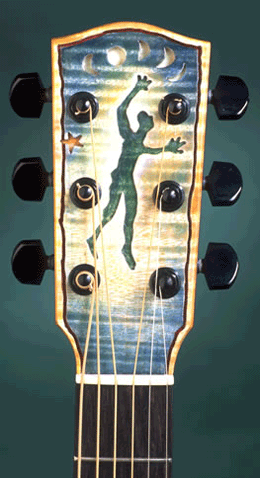 |
|
Linda Manzer’s “Floating Man. Photo by Brian Pickell. |
So you can’t argue that it degrades an instrument. It’s going into instruments that are worth small fortunes. And it’s achieving effects that couldn’t be accomplished otherwise, and it’ll take detail you can’t possibly do with solid shell without blowing it apart. It absolutely opens up a whole new realm of design that’s never historically been available. You could only dream about doing that with shell – you could never really do it, and now you can.
Is that because you have more surface material to work with?
CE: Well, no. It’s mainly because of the layering. Traditional solid shell will have natural fracture lines that run through it, usually at angles, and if you try to cut something, like your signature when you sign a check, and try and cut that thing out no thicker than your pen line, that just won’t hold up in regular shell, it just comes apart. It’s just too brittle and has too many continuous lines of fracture in it, where this stuff because it’s composed of multiple .010” thick layers that are epoxied together, it doesn’t have a continuous fracture, so you can cut incredibly fine detail, and it’s also softer, about ten percent softer, ten percent less dense than solid shell, so you can go with finer blades, you can cut with finer blades than solid shell and use less force.
Are lasers used to cut patterns?
CE: No, it’s never worked. The only guy to seriously cut shell with a laser, is Michael Gurian up in Seattle and he can’t really go past .015” thickness, in just single-layer shell. Once you get out past that, what happens is the edge of the cut, the edge of the shell where you are cutting, becomes real powdery, kind of a white powder, a flakey and rough looking edge, and my theory is that since shell contains about four percent moisture, water that’s permanently locked up in the shell at a molecular level, its in there it can’t get out, unless you bake it out.
But that water, since it’s locked into the shell at the molecular level, when that laser hits it, the water expands and kind of blows the side of the cut out. Well, in a paper-thin piece of shell the damage to that edge is so microscopic you can’t see it, it just looks clean. But as soon as you start doing thicker pieces, that damage becomes more evident and it starts looking like just a real degraded cut and no one has ever got around that. It’s really not a function of what kind or how strong your laser is. So no one’s really cutting, doing good work cutting shell, with a laser. There’s a couple places that are doing work with lasers on thicker shell but when you see it, it just looks rough, so that doesn’t count as a solution, you know.
If you have a shell and are going to start an inlay, what is the process? Do you know what design you want, say in a neck, or do you look at the shell and go “this would really look good if I…”
CE: That’s a good question, especially for a guy that doesn’t do inlay. Because that’s two separate philosophies of inlay. Grit Laskin’s philosophy is, he plans the design, he’ll draw the story, and then he goes back through his shell stash and he finds pieces of shell that will fit that. Where the musculature in the arm suggests an elbow, or the texture suggests feathers or whatever. He’ll get some, he’ll pick out pieces of shell and force them to fit his design.
There’s other guys, and I’m kind of in this school in a lot of ways, is I’ll have a whole stash of shell that has real special figure, patterns or something going on in it, and it will suggest something. I mean it will look like a pig snout or pair of eyes, or it will look like wool fleece, or feathers. Or it will look like a cloud figure, or look like a mountain side, and I’ll actually take that shell and design around its own intrinsic size scale; it will suggest something, and I’ll do that artwork directly on the shell and actually let the shell suggest and control the design, a totally different way of working.
But, Grit doesn’t work that way. He won’t let the shell dictate what’s going on, he let’s his artwork dictate to the shell. Two totally different philosophies, and there’s not a moral high ground on that. A lot of guys are probably a combination of the two. You’ll have a good idea, and then you’ll start looking for shell, and the shell will start suggesting things, where you go back and kind of maybe change your artwork to use a really cool piece of shell. And so it’s sort of a compromise between the two. That’s probably more where I am, I guess. I’ll do either one, whatever I think is going to get the best effect, you know?
Yeah, that’s an interesting question, most inlay guys don’t even know to think that way, although that’s changing rapidly through seminars given at luthier’s conventions by experts such as Laskin, Robinson, Threet, and Lavin.